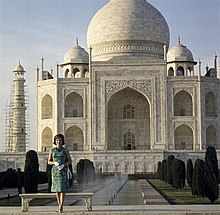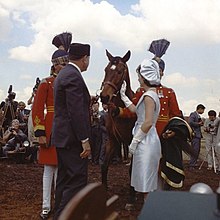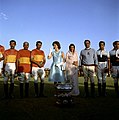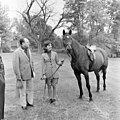Jacqueline Kennedy's 1962 goodwill tour of India and Pakistan

Jacqueline Kennedy took a goodwill tour of India and Pakistan in 1962. While the media gave widespread coverage on her fashion style, she functioned as an informal diplomat and developed her interest in arts and architecture, returning to India in later years to co-produce a book on Indian artwork.
Accompanied by her sister
Life estimated she wore 22 different outfits during the first nine days. Her visit to India likely influenced some of her later sari-like gowns. Some criticism was made of Kennedy being kept away from India's poverty, but the whole tour was generally aired favourably by the press. In 2019, her sister's personal photo albums of the trip went on auction at Christie's, New York.
Planning
According to
India tour

Kennedy was accompanied by her sister
On 14 March, Kennedy presented
Pakistan tour

Kennedy arrived in Pakistan on 21 March 1962, on a
Fashion style
Kennedy's fashion style, which she preferred not to talk about, was a regular topic of discussion in the media by the time of her India and Pakistan tour.[3] It was not her intention to have her wardrobe a focus of attention.[3] Worried about the response to her expensive wardrobe, she jokingly told her press secretary that "if you say anything, tell them it's secondhand and that I bought everything at the Ritz Thrift Shop".[3]
Working for the Chicago Daily News, Keyes Beech was one of the foreign correspondents who covered what they called Kennedy's "glorified fashion show".[7] Life estimated that during the India trip alone, she wore 22 different outfits, some designed by Joan "Tiger" Morse.[19][20] When she visited the Taj Mahal, she was photographed in a Morse designed green and blue floral-print cotton shift dress.[20][21] Several of her gowns were designed by Oleg Cassini.[3] He later recalled that " for the trip to India, I wanted Jackie to stand out, and we both felt that the visual impact of colour was important".[3] Her outfit colours therefore included bright pinks, green and white.[3] For the cruise along Lake Pichola, she wore an apricot silk zibeline, and in the silk markets of Benares, she was in lavender.[3][22] Her maid, Provy, took care of Kennedy's packing and had been taught how to set her hair.[7] According to Braden, Kennedy was generally quiet and kept reporters guessing her thoughts, the result of which was that they had "little more to scribble down than her "how sweet" when she saw camels dance or her "oh, how magnificent"" when she first saw the Taj Mahal".[7]
Response
LIFE dedicated several pages to the trip, the national press detailed every outfit both the sisters wore, and Newsweek gave the tour a mention as a "smash hit".[8] Elle Magazine hired Jacqueline Duheme to document the trip in a series of miniature watercolours.[8] LIFE reported that despite smaller crowds than others such as the Queen had attracted, “she [nevertheless] conducted herself magnificently.[13] It also reported that "days after she had gone people still called her "America Rani, Queen of America".[21] "Her every seam has been the subject of hypnotized attention from the streets of Delhi to the Khyber Pass", the journalist Anne Chamberlin reported.[13] Fashion historian Kimberly Chrisman-Campbell included the dress worn outside the Taj Mahal in her 2019 book Worn on This Day: The Clothes That Made History.[20] Kennedy herself described the tour as "a dream".[13] Criticism did appear in the Indian Press, who argued that Kennedy had not been exposed to poverty in India.[2] Biographer Barbara Leaming, noted that Kennedy's success in India added pressure to do likewise in Pakistan, and her five days there received a favourable response in the media.[4] The New York Times columnist Charlotte Curtis credited the success as due to what in her opinion Kennedy stood for... "foreign languages and an effort to understand foreign people in a country that tends to think it is the only country and that English is the only language."[6] The detail to her fashion style in news reports often diverted attention from the initial purpose of the visit.[3]
Influence and legacy

According to biographer Tina Santi Flaherty, "Kennedy was taken by the way the sari was draped".[19] Her visit to India likely influenced some of her later outfits.[19] She had bought back several saris with the intention to make them into dresses and upon her return to the US had for a short while popularised the sari and inspired several designers including Wesley Tann to design sari-inspired dresses.[23]
Following the tour, Jawaharlal Nehru kept a photograph of Kennedy in his private study for the rest of his life.[24] Like Kennedy, 30 years later Princess Diana was also photographed alone in front of the Taj Mahal.[21]
Radziwill's personal photo albums of the trip went on auction at Christie's, New York, in 2019.[12] One blue album with 89 photographs is titled “Visit of Mrs. John F. Kennedy to India (March 1962)”.[12] Photographs of her tour of Pakistan appear in a green album inscribed “Visit to Pakistan, March 21–26, 1962”.[12] Kennedy returned to India in 1984 and travelled with Naveen Patnaik researching Indian artwork and editing a book on the topic, titled A Second Paradise: Indian Courtly Life, 1590-1947.[19][25]
Gallery
-
Kennedy and Indira Gandhi
-
Kennedy rides an elephant in India
-
Kennedy at Lake Pichola, Udaipur
-
With Gayatri Devi and polo team in Jaipur
-
Kennedy feeds an elephant
-
Kennedy with President Rajendra Prasad
-
Galbraith and Kennedy at the U. S. Chancery, New Delhi
-
Kennedy with Khan and horse Sardar September 1962
References
- ISBN 978-1-4516-4844-7.
- ^ OCLC 1117765699.
- ^ a b c d e f g h i j Brown, B.P., 2012. Pretty in pink: Jacqueline Kennedy and the politics of fashion. State University of New York at Albany. PP. 51-57.
- ^ ISBN 0-684-86209-3.
- ^ ISBN 978-1-118-63980-1.
- ^ JSTOR 24517605.
- ^ a b c d e f g h Joan Braden, "An Exclusive Chat with Jackie Kennedy".Saturday Evening Post 235,. 12 May 1962), pp, 85-89.
- ^ a b c Dawson, Susan Elaine (2009). A Blueprint for Cold War Citizenship: Upper Class Women in the U.S. Foreign Policy, 1945-1963. The Ohio State University.
- ^ ISBN 978-1-59454-558-0.
- ^ Daitch, Vicki (18 September 2002) "Cecil W. Stoughton Oral History Interview". Merritt Island, Florida
- ISBN 978-0-19-515006-3.
- ^ a b c d Mzezewa, Tariro (10 October 2019). "Up for Auction: Snapshots of Jackie Kennedy in India and Pakistan". The New York Times. Archived from the original on 31 March 2022. Retrieved 31 March 2022.
- ^ a b c d Cosgrove, Ben (9 February 2012). "Jackie Kennedy: Photos of the First Lady on a 1962 Visit to India". LIFE. Archived from the original on 31 March 2022. Retrieved 31 March 2022.
- ^ a b "Invitation to Pakistan, March 1962: 21-26 | JFK Library". www.jfklibrary.org. Archived from the original on 9 April 2022. Retrieved 9 April 2022.
- ^ "First Lady Jacqueline Kennedy's (JBK) trip to India and Pakistan: Khyber Pakhtunkhwa, Pakistan, visit to Khyber Pass | JFK Library". www.jfklibrary.org. Archived from the original on 6 April 2022. Retrieved 6 April 2022.
- ISBN 978-1-4516-4844-7.
- ^ "First Lady Jacqueline Kennedy (JBK) rides with Muhammad Ayub Khan, President of Pakistan at Glen Ora, Middleburg, Virginia | JFK Library". www.jfklibrary.org. Archived from the original on 9 April 2022. Retrieved 9 April 2022.
- ^ Heller, Deane Fons (1963). Jacqueline Kennedy: The Warmly Human Life Story of the Woman All Americans Have Taken to Their Heart. Monarch Books. p. 170.
- ^ a b c d e Green, Cynthia (20 January 2020). "Of Jackie Kennedy's India Spiked Wardrobe". thevoiceoffashion.com. Archived from the original on 5 April 2022. Retrieved 5 April 2022.
- ^ ISBN 978-0-7624-9358-6.
- ^ ISBN 0-203-20046-2.
- ^ "Apricot Silk Zibeline Dress (MO 63.1294a) | JFK Library". www.jfklibrary.org. Archived from the original on 9 April 2022. Retrieved 9 April 2022.
- ISBN 978-1-350-13846-9.
- JSTOR 42896466.
- ISBN 978-0-385-19992-6.
External links
- "Reel America "Jacqueline Kennedy's Asian Journey" - 1962". 7 January 2021.
- Kennedy meets Nehru 1962. British Pathe.
- Kennedy in Pakistan 1962. British Pathe.
- "Visit of Mrs. John F. Kennedy to India (March 1962). [New Delhi:] Press Information Bureau, Ministry of Information and Broadcasting, Government of India [1962]". www.christies.com. Retrieved 4 April 2022.
- Kennedy during Holi 1962 Video on YouTube









